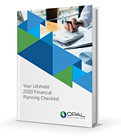5 Investment Themes to Watch in 2022
By Jesse Giordano, CFP® | January 25, 20222021 was a good year for the stock market, despite the ups and downs of the pandemic. The S&P 500 gained 26.9%—marking its third consecutive year of double-digit gains, according to Morningstar. All eyes are now on the year ahead. While it’s impossible to predict exactly what’s in store, we’ve rounded up five investment trends that are expected for 2022. Here are some important themes that we believe will drive returns this year.

1. Inflation and Supply Chain Issues
Supply chain shortages have been challenging consumers for months. Demand is high, inventory is tied up, and inflation is on the rise. In December 2021, the consumer price index jumped 7% from a year earlier—the highest uptick in 40 years. To provide some context, the Federal Reserve’s target rate of inflation is 2%. Jerome Powell, chair of the Federal Reserve, recently announced that he no longer thinks it’s accurate to describe this bout of inflation as transitory. Even when the squeeze on the global supply chain eventually eases, prices for oil and commodities may continue on an upward trend. Many experts also speculate that inflation runs deeper than supply gridlock.
Inflation effectively decreases your purchasing power. This can have a direct impact on your portfolio because it could diminish the real value of your investment gains over the long haul. Your financial advisor may recommend holding more securities like stocks to keep pace with inflation. Dividend-paying stocks can be particularly attractive. (More on this in a bit.)
2. Rising Interest Rates
The Federal Reserve has signaled that interest rate hikes will likely be on the horizon sooner than originally expected. As many as three rate jumps could be coming our way this year, with more to follow in the next two years. This would increase borrowing costs and cap the circulation of money, which could potentially cool the economy and prevent rapidly rising prices from becoming permanent.
Diversifying your investment portfolio is always important; even more so when interest rates are poised to go up. Your financial advisor might suggest focusing on sectors that have historically performed well in a rising-rate environment, such as financials. You might also explore repositioning your bond funds to those that adjust for inflation and rising rates.
3. Ongoing Geopolitical Risks
Equity investors may not know it, but geopolitical issues involving Russia and China could end up influencing their portfolios. The world is watching to see if Russia invades Ukraine, and the U.S. now says that it would respond swiftly with sanctions. How this would play out isn’t clear as U.S. trade relations with Russia aren’t very robust, but it’s still important to think about since Europe does trade heavily with Russia, so there could be a ripple effect there. Russia is a critical supplier of commodities; energy in particular. Prices could potentially be impacted by U.S. sanctions.
Tensions in China are also worth our attention. French parliament recently passed a motion condemning China for crimes against humanity and genocide against the Uyghur Muslim minority. In response to human rights concerns, the U.S. government has joined Britain and Australia in saying it will not send officials to the 2022 Winter Olympics in Beijing. Issues like these could discourage ESG investors from putting their money in Chinese companies.
This is all to say that the U.S. stock market does not exist in a bubble. Global politics can absolutely disrupt market activity and, in turn, individual investors.
4. Tighter Financial Regulation
Not all securities are equally regulated. Case in point: cryptocurrency. While stocks are primarily regulated by the Securities and Exchange Commission, crypto has its own ecosystem that’s largely unregulated. A tighter regulatory framework is expected in 2022 amid calls for greater transparency. The details remain unclear at this point, but digital assets like crypto are front and center.
There’s also talk that consumer protections will tighten for fintech companies that offer lending and payment products. On a similar note, the SEC is proposing that public companies disclose their risks related to climate change—something that could cause ESG investors to rethink their holdings, for better or worse.
5. Dividends Making Up a Greater Portion of Total Returns
No one can predict with 100% certainty how the stock market will perform this year, but there’s a general consensus among financial analysts that double-digit returns aren’t likely. And we can’t forget about inflation. When taken together, dividends become increasingly important. Since 1930, dividends have accounted for close to 60% of the total average return each decade for the S&P 500, according to Strategas Research Partners. Barron’s points to a recent Goldman Sachs study predicting that the S&P 500 will bump up dividend payments by roughly 6% this year. These cash-paying investments can help position your portfolio to keep up with inflation. In a rising-rates environment, it’s probably best to look to well-established companies that have a reputation for dividend growth.
Nothing is ever guaranteed in investing, but the trends outlined above are expected to materialize in 2022. The truth is that investors will have to wait and see what happens. Be that as it may, connecting with a skilled financial advisor can help you work through your unique concerns and put your portfolio in the best position for growth. Contact an Opal advisor today to schedule a personalized investment check-in.
Be a Smart Investor
Stay up-to-date with industry-leading information and news delivered straight to your inbox.
Get our timely insights delivered to your inbox (Blog)
Please remember that past performance may not be indicative of future results. Different types of investments involve varying degrees of risk, and there can be no assurance that the future performance of any specific investment, investment strategy, or product (including the investments and/or investment strategies recommended or undertaken by Opal Wealth Advisors, LLC [“OWA]), or any non-investment related content, made reference to directly or indirectly in this commentary will be profitable, equal any corresponding indicated historical performance level(s), be suitable for your portfolio or individual situation, or prove successful. Due to various factors, including changing market conditions and/or applicable laws, the content may no longer be reflective of current opinions or positions. Moreover, you should not assume that any discussion or information contained in this commentary serves as the receipt of, or as a substitute for, personalized investment advice from OWA. OWA is neither a law firm, nor a certified public accounting firm, and no portion of the commentary content should be construed as legal or accounting advice. A copy of the OWA’s current written disclosure Brochure discussing our advisory services and fees continues to remain available upon request or at www.opalwealthadvisors.com. Please Remember: If you are a OWA client, please contact OWA, in writing, if there are any changes in your personal/financial situation or investment objectives for the purpose of reviewing/evaluating/revising our previous recommendations and/or services, or if you would like to impose, add, or to modify any reasonable restrictions to our investment advisory services. Unless, and until, you notify us, in writing, to the contrary, we shall continue to provide services as we do currently. Please Also Remember to advise us if you have not been receiving account statements (at least quarterly) from the account custodian.



